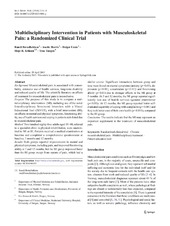| dc.contributor.author | Brendbekken, Randi | |
| dc.contributor.author | Harris, Anette | |
| dc.contributor.author | Ursin, Holger | |
| dc.contributor.author | Eriksen, Hege Randi | |
| dc.contributor.author | Tangen, Tone | |
| dc.date.accessioned | 2015-12-11T09:04:09Z | |
| dc.date.available | 2015-12-11T09:04:09Z | |
| dc.date.issued | 2016-02 | |
| dc.Published | International Journal of Behavioral Medicine 2016, 23(1):1-11. | eng |
| dc.identifier.issn | 1532-7558 | |
| dc.identifier.uri | https://hdl.handle.net/1956/10741 | |
| dc.description.abstract | Background Musculoskeletal pain is associated with comorbidity, extensive use of health services, long-term disability and reduced quality of life. The scientific literature on effects of treatment for musculoskeletal pain is inconclusive. Purpose The purpose of this study is to compare a multidisciplinary intervention (MI), including use of the novel Interdisciplinary Structured Interview with a Visual Educational Tool (ISIVET), with a brief intervention (BI), on effects on mental and physical symptoms, functioning ability, use of health services and coping in patients sick-listed due to musculoskeletal pain. Method Two hundred eighty-four adults aged 18–60, referred to a specialist clinic in physical rehabilitation, were randomized to MI or BI. Patients received a medical examination at baseline and completed a comprehensive questionnaire at baseline, 3 months and 12 months. Results Both groups reported improvements in mental and physical symptoms, including pain, and improved functioning ability at 3 and 12 months, but the MI group improved faster than the BI group except from reports of pain, which had a similar course. Significant interactions between group and time were found on mental symptoms (anxiety (p < 0.05), depression (p < 0.01), somatization (p < 0.01)) and functioning ability (p < 0.01) due to stronger effects in the MI group at 3 months. At 3 and 12 months, the MI group reported significantly less use of health services (general practitioner (p < 0.05)). At 12 months, the MI group reported better self-evaluated capability of coping with complaints (p < 0.001) and they took better care of their own health (p < 0.001), compared to the BI group. Conclusion The results indicate that the MI may represent an important supplement in the treatment of musculoskeletal pain. | en_US |
| dc.language.iso | eng | eng |
| dc.publisher | Springer | eng |
| dc.rights | Attribution CC BY | eng |
| dc.rights.uri | http://creativecommons.org/licenses/by/4.0 | eng |
| dc.subject | Randomized clinical trial | eng |
| dc.subject | Chronic musculoskeletal pain | eng |
| dc.subject | Multidisciplinary treatment | eng |
| dc.title | Multidisciplinary intervention in patients with musculoskeletal pain: a randomized clinical trial | eng |
| dc.type | Peer reviewed | |
| dc.type | Journal article | |
| dc.date.updated | 2015-11-06T09:38:43Z | |
| dc.description.version | publishedVersion | |
| dc.rights.holder | Copyright The Author(s) 2015 | eng |
| dc.identifier.doi | https://doi.org/10.1007/s12529-015-9486-y | |
| dc.identifier.cristin | 1243977 | |
| dc.relation.project | Sykehuset Innlandet HF: 150231 | |
| dc.subject.nsi | VDP::Medisinske Fag: 700 | |
| dc.subject.nsi | VDP::Medisinske fag: 700::Klinisk medisinske fag: 750::Fysikalsk medisin og rehabilitering: 764 | |
| dc.subject.nsi | VDP::Midical sciences: 700::Clinical medical sciences: 750::Physical medicine and rehabilitation: 764 | |
| dc.subject.keyword | Arbeid og helse / Working life and health | |
| dc.subject.keyword | Muskelskjelettsmerter / Musculoskeletal pain | |
| dc.identifier.citation | International Journal of Behavioral Medicine. 2016, 23 (1), 1-11 | |

